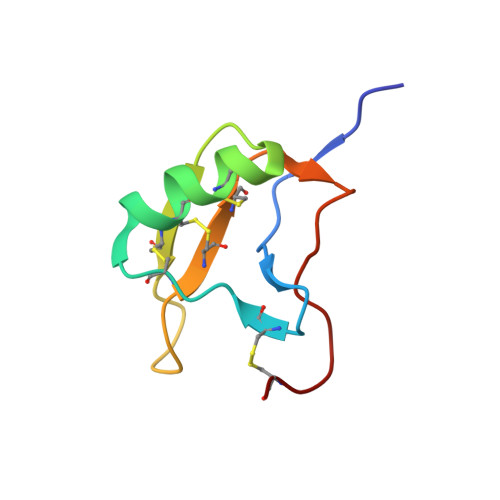Venom Peptides with Dual Modulatory Activity on the Voltage-Gated Sodium Channel NaV1.1 Provide Novel Leads for Development of Antiepileptic Drugs.
Chow, C.Y., Chin, Y.K., Walker, A.A., Guo, S., Blomster, L.V., Ward, M.J., Herzig, V., Rokyta, D.R., King, G.F.(2020) Acs Pharmacol Transl Sci 3: 119-134
- PubMed: 32259093
- DOI: https://doi.org/10.1021/acsptsci.9b00079
- Primary Citation of Related Structures:
6OHX - PubMed Abstract:
Voltage-gated sodium (Na V ) channels play a fundamental role in normal neurological function, especially via the initiation and propagation of action potentials. The Na V 1.1 subtype is found in inhibitory interneurons of the brain and it is essential for maintaining a balance between excitation and inhibition in neuronal networks. Heterozygous loss-of-function mutations of SCN1A , the gene encoding Na V 1.1, underlie Dravet syndrome (DS), a severe pediatric epilepsy. We recently demonstrated that selective inhibition of Na V 1.1 inactivation prevents seizures and premature death in a mouse model of DS. Thus, selective modulators of Na V 1.1 might be useful therapeutics for treatment of DS as they target the underlying molecular deficit. Numerous scorpion-venom peptides have been shown to modulate the activity of Na V channels, but little is known about their activity at Na V 1.1. Here we report the isolation, sequence, three-dimensional structure, recombinant production, and functional characterization of two peptidic modulators of Na V 1.1 from venom of the buthid scorpion Hottentotta jayakari . These peptides, Hj1a and Hj2a, are potent agonists of Na V 1.1 (EC 50 of 17 and 32 nM, respectively), and they present dual α/β activity by modifying both the activation and inactivation properties of the channel. NMR studies of rHj1a indicate that it adopts a cystine-stabilized αβ fold similar to known scorpion toxins. Although Hj1a and Hj2a have only limited selectivity for Na V 1.1, their unusual dual mode of action provides an alternative approach to the development of selective Na V 1.1 modulators for the treatment of DS.
- Institute for Molecular Bioscience, The University of Queensland, Brisbane, Queensland 4072, Australia.
Organizational Affiliation:
















